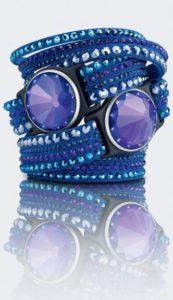Are You Experienced?
The title for Jimi Hendrix’s 1967 debut album might be the burning question facing retailers today.
It’s no longer about the store, but the experience the retailer provides, and it must be an integrated one,” advocates Pam Levine, Levine Luxury Branding, New York, noting that the conversation is ongoing, in and out of the store.
 Among the customer touch points, Levine cites: social media, website and ecommerce, advertising and collateral, traditional and new media, marketing, merchandise, selling channels, lighting, scent, pattern and texture, sound, gift packaging, fixtures and displays, store design, sales associates, and sales channels all create the customer experience. The most engaging retailers are multi-layered, with curiosity a powerful motivator.
Among the customer touch points, Levine cites: social media, website and ecommerce, advertising and collateral, traditional and new media, marketing, merchandise, selling channels, lighting, scent, pattern and texture, sound, gift packaging, fixtures and displays, store design, sales associates, and sales channels all create the customer experience. The most engaging retailers are multi-layered, with curiosity a powerful motivator.
A mega trend cited in Swarovski’s Gem Vision 2016 market research, “new retail environments” are generating fresh jewelry experiences in line with the latest evolution of immersive entertainments. “Spectacular new showrooms, galleries as well as luxury online platforms are redefining boundaries, creating interactive and personally relevant jewelry experiences, describes Cheryl Jester, trend & communication manager, Swarovski Genuine Gemstones and Created Stones, New York. “It’s a theme that runs throughout the luxury goods universe, but is especially significant in the jewelry world, where the purchasing environment is so entrenched in tradition and characterized by a very particular, often elitist, one dimensional, outdated style of presenting and selling jewelry.”
Jewelry boutiques, says Jester, now double as cultural venues, citing Stephen Webster’s L.A. store hosting art exhibitions and musical soirees, and offering a pop-up restaurant for special invited guests, creating the atmosphere of a private club and gathering of a cultured community.
The Digital Divide
A big part of creating the retail experience is leveraging the potential of, or meeting the digital expectations of your customers, cites a recent Deloitte study that says many retailers are failing. “That gap, the new digital divide, puts at risk much more than just online shopping revenue,” says the report. “It poses a serious threat to overall revenue and a bold challenge to the way they respond to, and anticipate, customers’ shopping habits in-store. Traditional retailers are leaving too much money on the table and allowing strictly online retailers to capture a growing share of revenue that could be theirs.”
Digital devices’ influence on in-store purchase behavior is growing much faster than anyone anticipated. Deloitte’s research shows that digital technologies influence 36% or $1.1 trillion of in-store retail sales, and this number will likely increase to 50% of in-store sales. This year: 84% of visitors report using digital for shopping-related activities before or during their most recent trip to a store. 22% of consumers spend more as a result of using digital—with just over half spending at least 25% more than intended. Consumers who use a device during their shopping journey convert at a 40% higher rate.
Given this acceleration, we’re at a tipping point in retail where digital channels should no longer be considered a separate or distinct business, reports Deloitte. Digital is fundamental to the entire business and shopping experience, in and out of the store. As this new reality begins to have a greater impact, retailers should change dramatically the way they think, measure, and invest in digital and address their customers’ digital needs and wants.
“The fact that we can be in a store and compare price and value has changed our shopping habits in everything with the bottom line,” says Andrew Kaplan, vice president of sales Rocket Redbox, Bronx, New York, who notes that if you don’t have free WiFi for your customers you’re doing them a disservice. “Consumers have come to expect WiFi access and if you don’t have it as a service to your customers, it’s a turn off.”
 Kaplan notes that with technology, the sky’s the limit in how you use it in the retail environment. “We will be seeing an absolute explosion of technology integrated in the retail environment.” Having computers and/or tablets in store for customization options or to teach and get greater product information offers multiple ways of telling your story and creating greater transparency.
Kaplan notes that with technology, the sky’s the limit in how you use it in the retail environment. “We will be seeing an absolute explosion of technology integrated in the retail environment.” Having computers and/or tablets in store for customization options or to teach and get greater product information offers multiple ways of telling your story and creating greater transparency.
Explore how the digital and physical shopping worlds are merged through the lens of the customer experience. “There’s a variety of technology out there designed to enhance customer experiences,” says Emily Graffagnino, visual merchandising and packaging manager for Stuller, Lafayette, Louisiana. “A simple smell machine can take customers just about anywhere right from your store. Think about holiday time, customers walking into your store and smelling pine, sugar cookies, or peppermint. It creates a memorable experience.”
Technology is key for custom design. Having a set space to consult makes a huge impression, says Graffagnino. She also notes that at a time when the cost of having physical inventory is a bit pricey, virtual inventory can be a lifesaver. “Today’s shoppers are expecting more options than ever before and virtual inventory, like Stuller’s Showcase, makes this possible.”
Find Your Experience
“The person who creates the experience is the person who must understand the customer best,” advocates retail designer Francesco Cordua. Research and trends help retailers feed in to positioning/story, personality, customer strategy and culture, adds Levine, who emphasized that retailers must know who they are and who their customers are to determine the experience they want to create.
“What’s your retail brand, beyond the mission statement,” challenges Levine, noting that retailers should not chart this course alone, but rather curate talent like branding consultants, interior designers, and freelance writers to create their message with the goal of taking customers on a journey. She notes that language is key to establishing message. “Good content is critical moving forward because that’s what brings a company to life.”
forward because that’s what brings a company to life.”
Moreover, attitude is paramount to engaging people. “Retailers who offer an experience have a kinetic quality that arises organically from the people, both staff and customers, in the store,” says Levine. “It’s the dynamic energy that results from excited, passionate people interacting with each other and that comes from the leadership in a company.”










